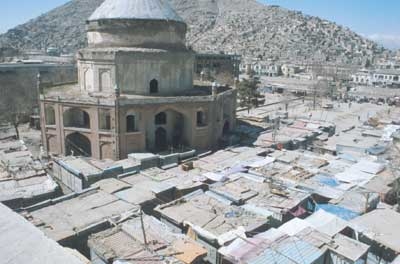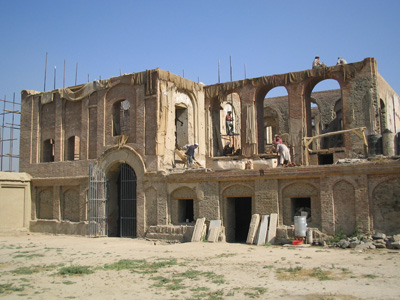AKDN’s cultural development activities are aimed at conserving and restoring Afghanistan’s cultural heritage, while stimulating local economic development and improving the quality of life for people living in surrounding neighbourhoods. In 2002, AKDN began the rehabilitation of Bagh-e-Babur, a walled and terraced garden containing the tomb of Babur, the founder of the Mughal Empire. AKDN’s improvements include the restoration of walls and the Queen’s Palace, the re-laying of water channels, the reconstruction of a caravanserai to provide space for a visitor’s centre, shops and offices, and the replanting of trees favoured by the Mughals. A range of community upgrading activities has also been carried out, improving water and sanitation facilities for 10,000 inhabitants of the surrounding residential area, which has been the focus of joint area-planning initiatives with Kabul Municipality.
AKDN has restored an imposing 19th-century mausoleum in central Kabul over the grave of Timur Shah, the king who made Kabul the Afghan capital in place of Kandahar. The surrounding open space has been reclaimed and landscaped to create a green park in the heart of the city.
Since 2003, war-damaged quarters of the old city of Kabul have been the focus of an AKDN programme to conserve key historic buildings, including houses, mosques, shrines and public facilities. Upgrading works have also improved living conditions for some 15,000 residents of the old city in the neighbourhoods of Asheqan wa Arefan, Chindawol and Kuche Kharabat.
In Herat, in western Afghanistan, a range of documentation, conservation and upgrading works has also been carried out since 2005 in surviving historic sections of the old city. This has been accompanied by supporting efforts to improve urban management and governance in the city. In addition, restoration work has been undertaken on an important Timurid shrine complex in Gazorgah, northeast of the city.
In all of this work, AKDN has tried to maintain a balance between conservation which is rooted in a sound understanding of the past, and development based on the aspirations and potential of surrounding communities.
In another initiative to preserve and develop Afghanistan’s cultural heritage, AKDN has established two schools of classical Afghan music in Kabul and Herat. The disruptions of the war have threatened the disappearance of the country’s classical music tradition. Under the Ustad-Shagird training scheme begun in 2003, master musicians teach students selected on merit, to preserve and pass on this musical tradition. Instruments taught include the rubab, delruba, sarinda, dutar and sitar.
Source: the AKDN website

